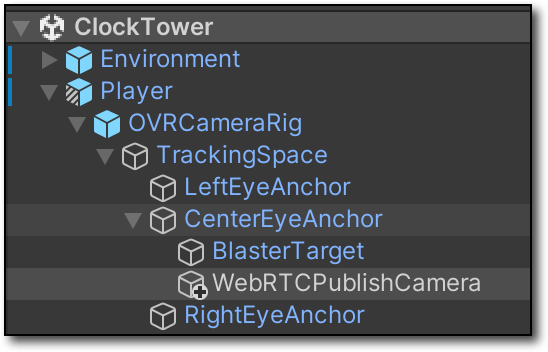dev-resources.site
for different kinds of informations.
Live Streaming from Unity - Broadcasting from a Meta Quest (Part 8)
We've already seen how to broadcast from a game built in Unity directly to a real-time live stream with Amazon Interactive Video Service (Amazon IVS). If you need a refresher, or you missed any of the previous posts, be sure to check them out to learn how to create an Amazon IVS stage, generate participant tokens, and broadcast from a Unity camera. In this post, we'll see that broadcasting from a VR game built for the Meta Quest is just as straightforward as it is from a non-VR game.
Adding a Streaming Camera
For this demo, we'll use the Unity First Hand demo app. Follow the instructions in that repo to get the game downloaded and setup in Unity, and once you've got the project open we'll add a new camera that will be used for the live stream. In the project explorer (Hierarchy view) add a camera as a child to CenterEyeAnchor called WebRTCPublishCamera.
Next, add a script to WebRTCPublishCamera called WebRTCPublish. This script is exactly the same as we have previously used, so I'll post it in its entirety below.
using System.Collections;
using System.Collections.Generic;
using System.Threading.Tasks;
using UnityEngine;
using Unity.WebRTC;
using UnityEngine.Networking;
[System.Serializable]
public class ParticipantToken
{
public string token;
public string participantId;
public System.DateTime expirationTime;
public static ParticipantToken CreateFromJSON(string jsonString)
{
return JsonUtility.FromJson<ParticipantToken>(jsonString);
}
}
[System.Serializable]
public class StageToken
{
public ParticipantToken participantToken;
public static StageToken CreateFromJSON(string jsonString)
{
return JsonUtility.FromJson<StageToken>(jsonString);
}
}
[System.Serializable]
public class StageTokenRequestAttributes
{
public string username;
public StageTokenRequestAttributes(string username)
{
this.username = username;
}
}
[System.Serializable]
public class StageTokenRequest
{
public string stageArn;
public string userId;
public int duration;
public StageTokenRequestAttributes attributes;
public string[] capabilities;
public StageTokenRequest(string stageArn, string userId, int duration, string[] capabilities, StageTokenRequestAttributes attributes)
{
this.stageArn = stageArn;
this.userId = userId;
this.duration = duration;
this.capabilities = capabilities;
this.attributes = attributes;
}
}
[RequireComponent(typeof(AudioListener))]
public class WebRTCPublish : MonoBehaviour
{
RTCPeerConnection peerConnection;
MediaStreamTrack videoTrack;
public AudioStreamTrack audioTrack;
Camera cam;
ParticipantToken participantToken;
async Task<StageToken> GetStageToken()
{
using UnityWebRequest www = new UnityWebRequest("http://localhost:3000/token");
StageTokenRequest tokenRequest = new StageTokenRequest(
"[YOUR STAGE ARN]",
System.Guid.NewGuid().ToString(),
1440,
new string[] { "PUBLISH", "SUBSCRIBE" },
new StageTokenRequestAttributes("ivs-rtx-meta-quest-demo-user")
);
www.uploadHandler = new UploadHandlerRaw(System.Text.Encoding.ASCII.GetBytes(JsonUtility.ToJson(tokenRequest)));
www.downloadHandler = new DownloadHandlerBuffer();
www.method = UnityWebRequest.kHttpVerbPOST;
www.SetRequestHeader("Content-Type", "application/json");
var request = www.SendWebRequest();
while (!request.isDone)
{
await Task.Yield();
};
var response = www.downloadHandler.text;
Debug.Log(response);
if (www.result != UnityWebRequest.Result.Success)
{
Debug.Log(www.error);
return default;
}
else
{
StageToken stageToken = StageToken.CreateFromJSON(www.downloadHandler.text);
Debug.Log(stageToken);
participantToken = stageToken.participantToken;
return stageToken;
}
}
async void Start()
{
StartCoroutine(WebRTC.Update());
peerConnection = new RTCPeerConnection
{
OnIceConnectionChange = state => { Debug.Log("Peer Connection: " + state); }
};
cam = GetComponent<Camera>();
videoTrack = cam.CaptureStreamTrack(1280, 720);
peerConnection.AddTrack(videoTrack);
AudioListener audioListener = cam.GetComponent<AudioListener>();
audioTrack = new AudioStreamTrack(audioListener) { Loopback = true };
peerConnection.AddTrack(audioTrack);
StartCoroutine(DoWHIP());
}
void Update()
{
}
IEnumerator DoWHIP()
{
Debug.Log("DoWhip");
Task getStageTokenTask = GetStageToken();
yield return new WaitUntil(() => getStageTokenTask.IsCompleted);
Debug.Log(participantToken.token);
Debug.Log(participantToken.participantId);
var offer = peerConnection.CreateOffer();
yield return offer;
var offerDesc = offer.Desc;
var opLocal = peerConnection.SetLocalDescription(ref offerDesc);
yield return opLocal;
var filteredSdp = "";
foreach (string sdpLine in offer.Desc.sdp.Split("\r\n"))
{
if (!sdpLine.StartsWith("a=extmap"))
{
filteredSdp += sdpLine + "\r\n";
}
}
using (UnityWebRequest www = new UnityWebRequest("https://global.whip.live-video.net/"))
{
www.uploadHandler = new UploadHandlerRaw(System.Text.Encoding.ASCII.GetBytes(filteredSdp));
www.downloadHandler = new DownloadHandlerBuffer();
www.method = UnityWebRequest.kHttpVerbPOST;
www.SetRequestHeader("Content-Type", "application/sdp");
www.SetRequestHeader("Authorization", "Bearer " + participantToken.token);
yield return www.SendWebRequest();
if (www.result != UnityWebRequest.Result.Success)
{
Debug.Log(www.error);
}
else
{
var answer = new RTCSessionDescription { type = RTCSdpType.Answer, sdp = www.downloadHandler.text };
var opRemote = peerConnection.SetRemoteDescription(ref answer);
yield return opRemote;
if (opRemote.IsError)
{
Debug.Log(opRemote.Error);
}
}
}
}
async void OnDestroy()
{
Debug.Log("OnDestroy");
peerConnection.Close();
Debug.Log(peerConnection.IceConnectionState);
peerConnection.Dispose();
if (videoTrack != null) videoTrack.Dispose();
if (audioTrack != null) audioTrack.Dispose();
}
}
We've got a few classes to model stage token requests. Those requests are posted to a service which returns a stage token (see the simple-ivs-token-service script for an example implementation). We establish a peerConnection, get a remote SDP, and wire the camera up to the peerConnection as a MediaTrack. That's it!
Streaming VR Gameplay
At this point we're ready to test it out. Launch the First Hand demo on a Meta Quest device, and check the output via your own custom web based interface (or the CodePen that we used before).
Summary
In this post, we used the techniques that we've learned in this series to broadcast a real-time stream to Amazon IVS from a Meta Quest VR headset. We could add a button that the player has to press to start the stream, integrate viewer chat (see part 4), spawn dynamic game elements (part 5) and much more - the possibilities are exciting and endless. In the next post, we'll wrap up this series with a look at using the techniques we've learned so far to broadcast a game directly to Twitch instead of an Amazon IVS stage.
Featured ones:
